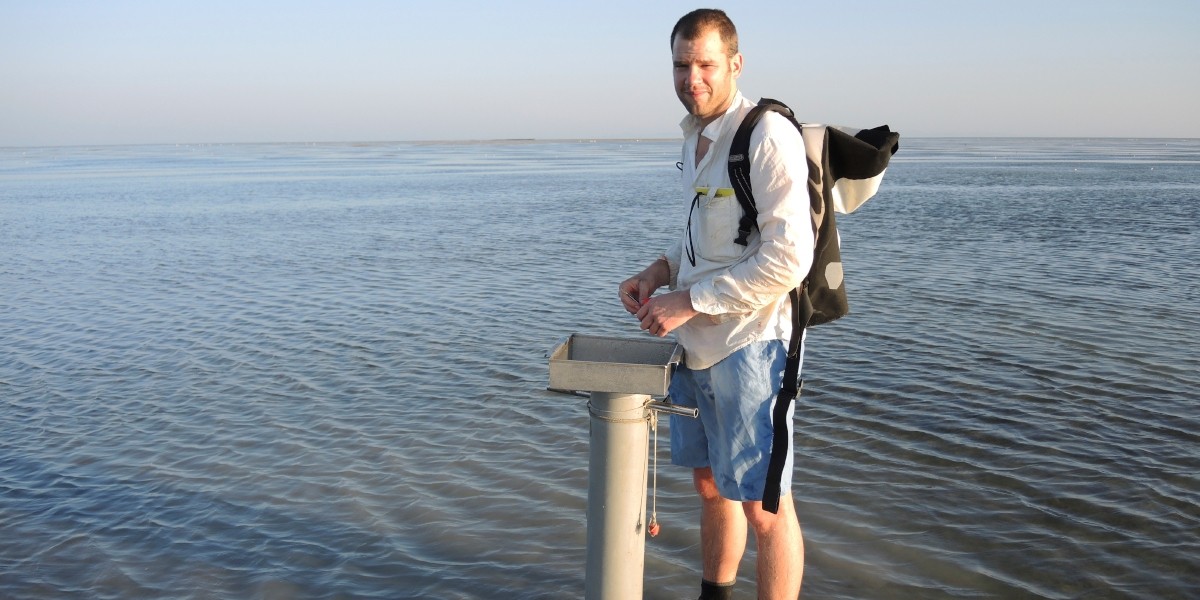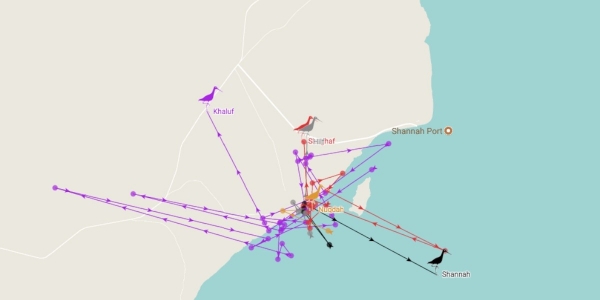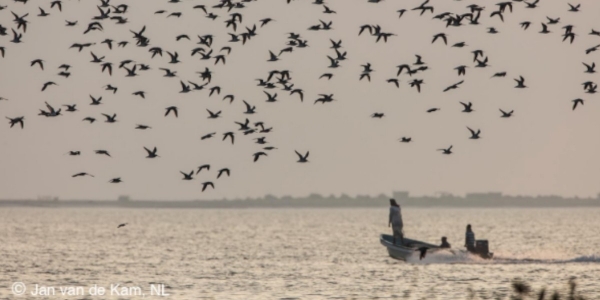Roeland Bom

Interests
Research interests
I am a postdoctoral researcher with a prime interest in how marine organisms coope with a rapidly changing world. In my recent work I study the migratory routine of Bar-tailed Godwits wintering in West Africa and Oman.
Functions
Functions
Publications
Key-publications
Please find my complete list of NIOZ-publications at the bottom of this webpage. You can download all my publications on ResearchGate.
Education
Professional education
Awards
Awards and Prizes
Other
Bar-tailed godwits
Linked news
Tuesday 21 November 2023
Changing climate homogenizes diversity in migratory birds
Changing climate may slowly erode the difference between two subspecies of bar-tailed godwits. That warning is voiced by bird researchers from the Royal Netherlands Institute for Sea Research (NIOZ) and the University of Amsterdam (UvA) in the latest…
Friday 30 June 2023
Dossier: warm sea and ocean water
Global warming dominates global news. Here, rising atmospheric temperatures are usually the common thread. But of all the extra heat trapped by our greenhouse gas emissions, only 1 per cent remains in the air. The vast majority (89 per cent)…
Monday 07 November 2022
Spectacular skate returns to North Sea
The skate is a ray that can easily reach a meter in length, up to almost three meters from head to tail. This spectacular fish is returning to the North Sea. An analysis of historical data, by NIOZ researchers Anieke van Leeuwen and Roeland Bom,…
Monday 18 October 2021
New subspecies of bar-tailed godwit officially recognized
As of today there are no longer just five subspecies of bar-tailed godwits, but six. In the latest issue of the ornithological journal Ibis, a new subspecies is described by an international team of biologists. “Limosa lapponica yamalensis has a…
Tuesday 29 June 2021
During epic migrations, great snipes fly at surprising heights by day and lower by night
Don't let the great snipe's pudginess fool you. A stocky marsh bird with a 20-inch wingspan, great snipes are also speedy marathoners that can migrate from Sweden to Central Africa in just three days, without even stopping to eat, drink, or sleep.…
Thursday 08 October 2020
Crabs are key to ecology and economy in Oman
The intertidal mudflats of Barr Al Hikman, a nature reserve at the south-east coast of the Sultanate Oman, are crucial nursery grounds for numerous crab species. In return, these crabs are a vital element of the ecology, as well as the regional…
Friday 19 June 2020
The North Sea’s forgotten angels
The presence of Angelsharks in the North Sea has faded from our memory. In a recent publication in Marine Biology, WWF nature conservationists and NIOZ researchers urge that we put top predators from earlier centuries back into the ‘baseline’ picture…
Tuesday 17 December 2019
Catching birds at the Bijagós Archipelo in Guinea-Bissau
This story describes the first of several bird catches made by researchers from the NIOZ Netherlands Institute for Sea Research (Roeland Bom) and the University of Aveiro (José Alves and Afonso Rocha) in the Bijagós Archipelago between 11 and 28…
Monday 08 October 2018
Wapenwedloop in 'oerwadden' in Midden-Oosten
In het Sultanaat Oman, aan de zuidoostkust van het Arabische Schiereiland, is door het Koninklijk Nederlands Instituut voor Onderzoek der Zee (NIOZ) voor het eerst een uitgebreide fauna-inventarisatie gemaakt. De Nederlandse bioloog Roeland Bom deed…
Wednesday 09 March 2016
Bar-tailed Godwits in the Middle East can be followed via internet
In November 2015 a group of NIOZ researchers travelled to the Middle East. Together with biologists from the Sultan Qaboos University, they attached radio transmitters on ten female Bar-tailed Godwits in the intertidal area Barr Al Hikman in the…
Linked blogs
Tuesday 16 May 2023
Ecologisch onderzoek in de Waddenzee, 2023
Onderzoekers van het NIOZ volgen al jaren wat er gebeurt met het leven in de Waddenzee. Sommige datasets zijn al langer dan 30 jaar. Veranderingen in het bodemleven worden in kaart gebracht met het SIBES-project. Elk jaar worden dieren in ruim 5.000…
NIOZ publications
-
2022
Bom, R.A.; Ebbinge, M. (2022). Simple and complex burrow morphology in two Macrophthalmus species on the intertidal mudflats of Barr Al Hikman, Sultanate of Oman. J. Nat. Hist. 56(5-8): 475-485. https://dx.doi.org/10.1080/00222933.2022.2093679van der Kolk, H.-J.; Desmet, P.; Oosterbeek, K.; Allen, A.M.; Baptist, M.J.; Bom, R.A.; Davidson, S.C.; de Jong, J.; de Kroon, H.; Dijkstra, B.; Dillerop, R.; Dokter, A.M.; Frauendorf, M.; Milotic, T.; Rakhimberdiev, E.; Shamoun-Baranes, J.; Spanoghe, G.; van de Pol, M.; Van Ryckegem, G.; Vanoverbeke, J.; Jongejans, E.; Ens, B.J. (2022). GPS tracking data of Eurasian oystercatchers (Haematopus ostralegus) from the Netherlands and Belgium. ZooKeys 1123: 31-45. https://dx.doi.org/10.3897/zookeys.1123.90623
-
2021
Lindström, A.; Alerstam, T.; Andersson, A.; Bäckman, J.; Bahlenberg, P.; Bom, R.A.; Ekblom, R.; Klaassen, R.H.G.; Korniluk, M.; Sjöberg, S.; Weber, J.K.M. (2021). Extreme altitude changes between night and day during marathon flights of great snipes. Curr. Biol. 31(15): 3433-3439. https://dx.doi.org/10.1016/j.cub.2021.05.047van der Winden, J.; Hotting, M.; Weeda, S.; Vos, R.; Bom, R.; Kreetz, T.; Cimiotti, D.; Dreef, C. (2021). Lachstern broedt in het pionierlandschap van Marker Wadden. Limosa (Amst.) 94: 124-127
-
2020
Bom, R.A. (2020). Book review: Mudflat Ecology. Ardea 108(1): 109-110. https://doi.org/10.5253/arde.v108i1.a12
-
2018
Bom, R.A. (2018). Arabian muds: A 21st-century natural history on crab plovers, crabs and molluscs. PhD Thesis. University of Groningen: Groningen. ISBN 978-94-028-11803. 367 pp. https://hdl.handle.net/11370/538fd42f-2473-4896-b11b-6655d3dd1671
-
2016
de Fouw, J; Bom, R.A.; Klaassen, R.H.G.; Müskens, G.J. D. M.; de Vries, P.P.; Popov, I.Y.; Kokorev, Y.I.; Ebbinge, B.S.; Nolet, B.A. (2016). Breeding in a den of thieves: pros and cons of nesting close to egg predators. Ecosphere 7(6): e01353. dx.doi.org/10.1002/ecs2.1353
-
2014
Bom, R.A.; Abma, J.F.; Pieters, A.L. (2014). Doortrek van Bokjes in Laag Holland. Limosa (Amst.) 86: 209-216Bom, R.A.; Bouten, W.; Piersma, T.; Oosterbeek, K.; van Gils, J.A. (2014). Optimizing acceleration-based ethograms: the use of variable-time versus fixed-time segmentation. Movement Ecology 2(6): 1-8. hdl.handle.net/10.1186/2051-3933-2-6Ens, B.J.; Bom, R.A.; Dokter, A.M.; Oosterbeek, K.; Jong, J.D.; Bouten, W. (2014). Nieuwe ontdekkingen en mogelijkheden in het onderzoek aan Scholeksters dankzij het UvA Bird Tracking Systeem. Limosa (Amst.) 87: 117-128
-
2012
Shamoun-Baranes, J.; Bom, R.; van Loon, E.E.; Ens, B.J.; Oosterbeek, K.; Bouten, W. (2012). From Sensor Data to Animal Behaviour: An Oystercatcher Example. PLoS One 7(5): e37997. dx.doi.org/10.1371/journal.pone.0037997
Linked projects
Cascading predator-prey effects
Supervisor
Jan van Gils
Funder
Netherlands Organization for Scientific Research
Project duration
1 Oct 2010 - 30 Sep 2017

